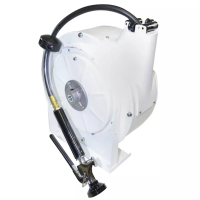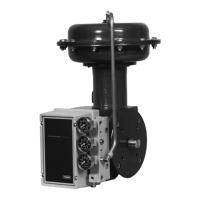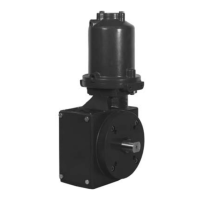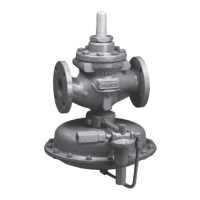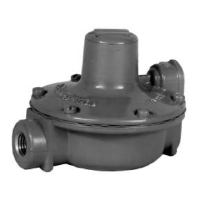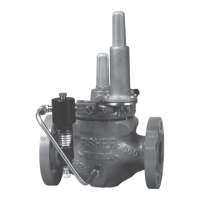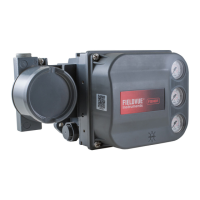4195KA, KB, and KC Series
4–8
Figure
4–4. Alignment of the Process Pointer with the Set
Point Indicator
W4039 / IL
W4038 / IL
sufficiently stabilized in steps 9 through 13. Repeat
steps 8 through 19.
21. When the flapper is correctly aligned, set the pro-
portional band to 400 percent in the desired controller
action and replace the proportional band indicator cov-
er. If link 1 was disconnected, reconnect link 1 to the
input element using the same hole noted in step 8.
22. If the controller has the external feedback option,
disconnect the outside tubing which connects the ex-
ternal feedback connection to the output connection.
23. For controllers with anti-reset windup (suffix letter
F), remove the two machine screws, valve cover and
two O-rings installed in step 1 of this procedure. Install
the anti-reset windup relief valve (key 55) with the ar-
row pointing in the direction recorded in step 1.
Anti-Reset Windup (suffix letter F)
Differential Relief Valve Calibration
Calibration for the differential relief valve to relieve
on rising controller output pressure
1. Provide a means of measuring the controller output
pressure by connecting the controller output to a pres-
sure gauge (open-loop conditions must exist). Do not
apply supply pressure at this time.
2. Set the reset adjustment to 0.01 minutes per re-
peat (wide open) and the rate adjustment (4195KC
Series only) to the OFF position.
3. For a controller with manual set point, move the set
point indicator to the mid-scale mark on the process
scale. For a controller with remote set point, adjust the
remote set point pressure until the set point indicator
is at the mid-scale mark on the process scale.
4. Set the proportional band to 100 percent in either
the DIRECT or REVERSE action depending on the
application requirements.
5. Refer to figure 4–3 for the location of the anti-reset
windup differential relief valve. For the differential relief
valve to relieve on rising controller output pressure,
install the valve so the arrow on the valve points down.
To change the direction of the arrow, loosen the two
mounting screws, pull the valve out, and reinstall the
valve with the arrow pointing down. Tighten the two
mounting screws.
6. Provide a regulated supply pressure to the control-
ler. Do not exceed the normal operating pressure in
table 1–6.
Note
Because of the high controller gain with
the reset adjustment at 0.01 minutes per
repeat, the controller output will not bal-
ance perfectly in the following step. If
the controller output is stable for
approximately 5 seconds, it is adequate-
ly balanced.
7. Increase the process pressure (or vacuum for a
vacuum controller) to the controller until the controller
output pressure balances at 6 psig (0.4 bar) for a 3 to
15 psig (0.2 to 1.0 bar) output range or 12 psig (0.8
bar) for a 6 to 30 psig (0.4 to 2.0 bar) output range.
8. Turn the reset adjustment to the CLOSED (4195KB
Series) or OFF (4195KC Series) position.
9. Increase the controller output pressure in small
steps (approximately 0.5 psig (0.04 bar)) by changing
the process pressure to the controller or by changing
the controller set point. After each change in process
pressure or set point, the controller output pressure
should quickly change and then stabilize at the new
value.
10. Continue to change the controller output pressure
in 0.5 psi (0.04 bar) steps and check the output pres-
sure after each step to make sure it stabilizes. At
some point, the controller output will start to ramp up-
ward to supply pressure with no further change to the
controller input or set point. Record the controller out-
put pressure where this ramping action begins be-
cause this is the point at which the differential relief
valve has relieved.
11. To obtain the differential relief valve differential
setting, calculate the difference between the original
controller output pressure in step 7 and the controller
output pressure recorded in step 10.

